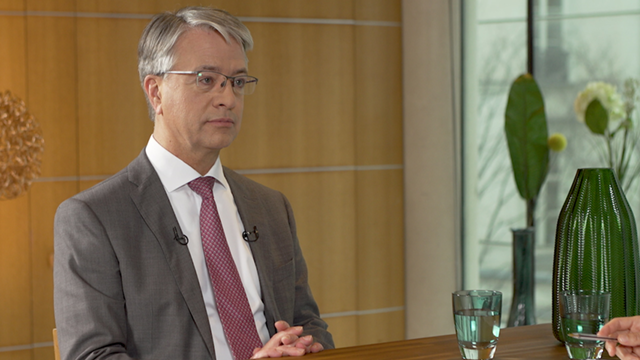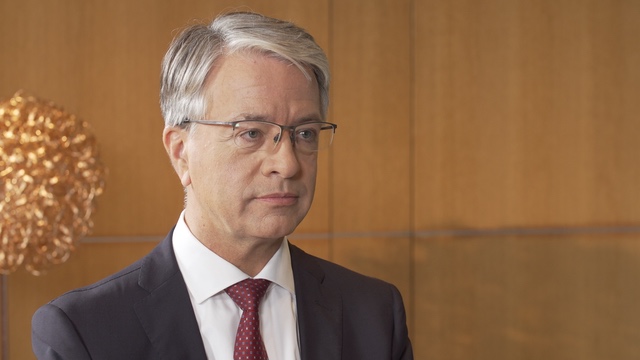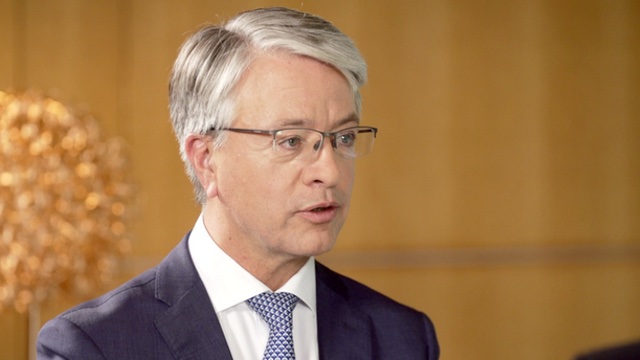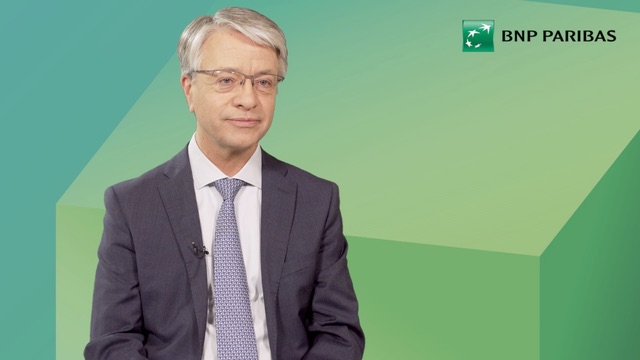EuroBusiness Media (EBM): BNP-Paribas, one of Europe’s largest banks, reports results for the full year 2012. Jean-Laurent Bonnafé, welcome. You are the CEO of BNP-Paribas. What are your comments on the Group's performance for the full year and in the fourth quarter?
In 2012, BNP Paribas delivered solid results in a challenging environment, successfully completing the adaptation plan announced in September 2011. Net income for the Group reached 6.6 billion euros, marking an 8.3% improvement on the previous year and confirming a competitive profit generation capacity.
Revenues of the operating divisions showed good resilience, benefitting from the diversification of our business model while good cost control was confirmed across the board.
Over the full year, cost of risk showed a moderate increase in a difficult economic environment, reaching a level of 58 basis points as a percentage of customer loans.
During the year BNP Paribas continued to increase its deposit base as confirmed by Retail Banking deposits which were up 7% compared to the previous year. Domestic Markets contributed with a 5% increase. And similarly, Corporate Banking deposits in CIB reached 55 billion euros, 18% higher than a year ago.
In the fourth quarter the operating divisions showed a good operating performance as compared with the fourth quarter of 2011, which was impacted by the sovereign crisis. Cost of risk increased in specific areas, notably at BNL in Italy and in CIB where one large ticket explained most of the increase. Excluding one offs, the net result for the quarter amounted to almost 1.1 billion euros.
In 2012 BNP Paribas completed its adaptation to the changing environment both in terms of solvency and liquidity. On the solvency front our common equity Tier 1 ratio under fully loaded Basel 3 reached 9.9% at year-end, exceeding our original target of 9%. In terms of liquidity we more than doubled our surplus of stable funding to 69 billion euros at the end of the year.
All this translates into continuing value creation for our shareholders as our book value per share increased to about 61 euros while the tangible book value per share exceeded 50 euros.
EBM: In the current challenging environment, how did your Domestic Markets perform? What do you think are the levers for the future development of this business?
Our Domestic Markets continued to generate solid results in a challenging environment. I have just mentioned the contribution in terms of deposit growth while the trend for loans, while slowing down, still showed a 1.3% growth in the year.
Revenues remained stable in the year as dynamic commercial activity helped to offset the impact of the low rate environment and the lower level of new loans production. Cost control was particularly effective in all areas of activity leading to an improvement in cost/income ratios in all our markets. Cost of risk remained moderate in France and Belgium while in Italy it picked up especially in the latter part of the year.
Pre-tax income remained at 4 billion euros, almost in line with the historic high of the previous year.
Looking beyond 2012, we have already started preparations for tomorrow’s Retail bank. We are investing in digital innovations and in the development of new payment systems. We are also adapting our networks to our clients’ changing behaviours looking for example for more advisory and less basic banking transactions in our branches.
Technological innovation will go hand in hand with further cost optimisation in order to lead to further improvements in operating efficiency in our Domestic Markets.
An ambitious plan along these lines has already been launched in Belgium in December: “Bank for the future”.
EBM: And what about the rest of your Retail business: how has that fared in 2012?
Well, starting with EuroMed, we saw a strong commercial development driven by double-digit deposit growth, particularly in Turkey. Loan growth amounted to about 3.5% with Turkey showing double-digit growth also on this side while Ukraine continued to decrease.
In Morocco and Tunisia we continued to roll out our multi-channel offer, and in Turkey we continued to improve operating efficiency while developing the cross-selling with CIB and Investment Solutions.
Overall, results increased very significantly exceeding 250 million euros in terms of pre-tax income.
Moving to the US, our Retail banking arm BancWest also performed strongly in an improving economic context. Deposits increased over 8% while loans were up 3.5% with a significant performance in terms of corporate loans.
We continued to invest in our Private Banking where we now have over 126,000 clients. Moreover we made good progress with the modernization of the network and the introduction of mobile banking services.
Pre-tax income increased 7% to 859 million euros for the full year, showing BancWest’s strong profitability.
If we move now to Personal Finance, commercial activity was marked by the signing of new partnerships for example with Sony in Germany and CORA in France. Our joint-venture with Commerzbank in Germany is proving a success which we aim to replicate in Russia where we recently signed a JV agreement with Sberbank.
Despite the impact of new regulations in France, this commercial drive combined with the effect of the adaptation plan on costs resulted in an increase in pre-tax income which stood at close to 1.3 billion euros for the full year.
EBM: What were the main highlights in your Investment Solutions division? Can you update us on the evolution of your assets under management?
Investment Solutions performed strongly in 2012 with revenues up nearly 5% and pre-tax income over 16% higher even adjusted for the impairment of Greek debt in 2011.
Revenues were driven by a good development of the Wealth Management business, strong growth in Insurance, and positive dynamics in Securities Services. Asset management revenues were impacted by lower outstandings but this was partly offset by effective cost control as a result of the implementation of the adaptation plan.
Concurrently, we continued to invest in the business development of Insurance, Wealth Management and Securities Services, especially in the Asia-Pacific region.
In 2012 Investment Solutions saw net inflows in Wealth Management and Insurance while Asset Management showed inflows into monetary and bond funds with outflows in the other funds.
Assets under management reached close to 900 billion euros marking a 5.6% increase on the previous year.
All businesses contributed positively in the course of the year, driven essentially by the recovery of financial markets.
EBM: Could you comment on your CIB activities in 2012? How were they impacted by the implementation of your adaptation plan?
In 2012, CIB revenues were 10% lower net of the one off impacts of sovereign debt and credit disposals, that is a reduction of 1.1 billion euros in line with the announced impact of the adaptation plan. This reduction was mainly due to our deleveraging in Corporate Banking. Our Capital Market activities showed good resilience in the European context, customer activity being somewhat volatile during the year.
Effective cost control in conjunction with the completion of the staff reduction plan ensured that we maintained a competitive level of operating efficiency. In fact our cost/income stood at 62.3% net of one offs despite continuing investments in Cash Management and in deposit gathering.
In Fixed Income we remained number 1 for bond issues in euros for the third consecutive year and ranked number 8 when considering all international issues. Equity and Advisory was hampered by limited client demand but confirmed solid rankings, as for example in EMEA Equity-linked where we were number 3.
As I have said, in Corporate Banking the reduction in loans outstanding was due to our adaptation plan. At the same time, we have continued to develop our “Originate to Distribute” model with some landmark deals as for example in Asset Finance. Corporate Banking confirmed its leading positions, as in loan syndication where we ranked number 1 in Europe and in Trade Finance where we were second best provider worldwide according to Euromoney.
In addition, we continued to strengthen our Cash Management – in which we are a leader in the Euro zone and rank n°5 worldwide - and to develop our deposit gathering capabilities. The success on this front is clearly shown by the sizeable increase in client deposits that have reached 55 billion at year end 2012.
All in all, I would say that 2012 has been an important transition year for our CIB which has successfully combined its adaptation to the new environment and the preservation of its competencies and capabilities. This success has also been recognized by IFR which assigned the prestigious Bank of the Year award to BNP Paribas for 2012!
EBM: Short-term liquidity rules have now been finalized using more realistic assumptions. Do you think you will comply with the new LCR before the phasing-in in 2015? Could this involve additional deleveraging?
Not all aspects of the ratio have been fully clarified and several assumptions remain far from real life liquidity. What I can say is that, BNP Paribas was basically compliant with the 100% LCR requirement at year end 2012. Hence, there is no need for any additional deleveraging!
EBM: Given the current environment, what are the levers that management can use to improve profitability in the coming quarters, assuming that macroeconomic headwinds remain as they are?
In the current context of low growth in the Euro zone, we have launched “Simple & Efficient”, our ambitious plan to simplify the Group’s operations and improve its operating efficiency. Over the next 3 years we intend to invest 1.5 billion euros in order to generate by 2015 yearly cost savings of 2 billion euros. These savings shall come from all businesses of the Group across all geographies and shall be split essentially in line with the current business mix of the Group, that is to say: 1/2 Retail, 1/3 CIB and 1/6 Investment Solutions.
The plan centres on 5 axes of transformation ranging from reviewing processes to rationalising tools to cost optimization. It also includes transversal approaches to enhance operating efficiency such as digitalization of processes or increased levels of delegation.
To date over 1,000 initiatives have already been identified in the Group showing the mobilization of all businesses and functions.
The importance of this plan is such that its steering shall be followed by the Top Management.
EBM: Last year, you indicated that you wish to expand your presence in Asia. In recent months, several investment banks have announced cut-backs in their Asian operations. What are your plans in this region which seems to be a very competitive market?
I confirm that we want to further develop the Group’s footprint in that fast growing region. Developing in Asia-Pacific is actually a key lever for the Group’s future profitability and we are already one of the best positioned international banks in Asia-Pacific with a presence in 14 countries and full banking licenses in 12 of them.
We already have strong platforms in the region with recognized franchises. For example in Cash Management, we rank number 5 in Asia, and in Trade Finance we have 25 trade centres in place and were voted second best Trade Finance Bank in Asia in 2012. And I can continue with Fixed Income where we are a top player in Derivatives. In addition to CIB, we also have significant areas of expertise in Private Banking, where we manage some 30 billion euros and rank number 8 in Asia, and Insurance where we are the 7th largest non-Asian player in the area with a presence in 6 countries.
Our presence in the region is complemented by specific partnerships with large local players such as State Bank of India, Shinhan group in South Korea, Bank of Nanjing, just to mention a few.
We have ambitious plans in the region. We actually aim to increase revenues generated in Asia-Pacific from the current 2 billion to over 3 billion by 2016. That’s an annual growth rate of 12% over the next 4 years!
In order to do this, we want to increase our set up and will hire some 1,300 additional people over the next three years in the region. We’ll target both Corporates and Investors in order to increase both our funded assets and our deposit base in line with our revenues’ target. To ensure that we get there, we have a member of the Comex who will steer the plan directly from Asia.
I am confident that BNP Paribas can play an increasingly important role in the development of the Asian economy and that Asia-Pacific can represent an increasingly important part of our core earnings.
EBM: You have one of the highest capital ratios in the banking sector, already Basel 3 compliant and well above most of your peers. Therefore, what options can you use to leverage this competitive edge?
Undoubtedly, Common Equity Tier 1 ratio at nearly 10% BNP Paribas has the opportunity to focus on capturing growth opportunities. 2013 will therefore be a year of preparation of our 2014-2016 development plan.
The first stage of this plan is represented by the launch of Simple & Efficient, our ambitious plan to improve the Group’s operating efficiency that I mentioned before.
The second stage will comprise development plans by region or business, the first example being our Asia-Pacific plan which I’ve just briefly summarized.
Development plans will be progressively announced during the year with the objective of presenting a full 2014-2016 development plan at the beginning of next year.
Therefore, to fully answer your question, please be patient as you’ll see in the course of the year, the full range of options that we are currently working on.
EBM: Jean-Laurent Bonnafé, CEO of BNP Paribas, thank you very much.
Jean-Laurent Bonnafé: Thank you.






